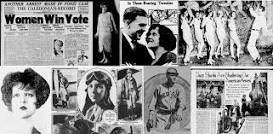Lecture three: The Roaring Twenties in America
The Roaring Twenties was a period in American history when there was a massive social and technological change in addition to the movements of women and African-Americans. The era is also known as the Jazz Age, which witnessed changes in many fields, social, economic, technological, and political. After World War 1, women became more liberated, known as "the flappers". Also, the speakeasies broke the laws of prohibition, and the stock markets, which were rising. Of course, this Sudden Change was not without consequences, Americans feared racial diversity and careless moral standards of City Life. However, some Americans like women and Afro-Americans enjoyed prosperity and progress.
There was a shift in social behavior as a result of the new culture of “the Jazz Age”. In addition, there was an economic boom and a variety of goods for consumers, which changed the lives of many Americans. Those goods included TVs, refrigerators, vacuum cleaners, washing machines, which facilitated life and made it more comfortable. Because Americans had more time, they started some leisure activities, practicing sports, going on vacations, and watching movies. Work was no more a source of pride and honor but only a means to obtain more products and entertainment. It is vivid that the twenties changed the standards of living for many Americans, yet some of them were more influenced than others.
After the ratification of the 19th amendment in 1920, women were given the right to vote and a sense of liberation. Consequently, a new type of women appeared known as the flappers. They wore short skirts, their hair was bobbed and they smoked and drank in public. Before World War 1, many social norms were restricting the roles of women in society, however, by the twenties, women would define society's roles themselves. Flappers actually changed women's Behavior, talk, dress, and reactions in society.
Not only social changes, but cultural and artistic ones also appeared too during the Jazz Age. A cultural movement called "surrealism" emerged in the early twenties, which greatly affected writing and visual arts. Surrealists tried to unleash their uncontrolled imagination through their writings and work. There were new techniques like automatic painting, decalcomania, and frottage. Without forgetting Art Deco, which became extremely famous during the twenties. It made use of aluminum and stainless steel. The Art Deco movement influenced architecture and the Art of decoration, and changed the perception of art throughout America.
Another social, cultural and artistic movement emerged known as the "Harlem Renaissance". Harlem was home to the black community that created ties with the artistic mainstream of New York. Writers as Cantee Cullen and Langston Hughes were sponsored and published by the white press and even cast many black actors. The Harlem Renaissance was thus an artistic, literary, and intellectual movement that altered the image of Afro Americans in the USA. They were given a new identity with a new culture that helped them spread their legacy.
To
conclude, we can say that the Roaring Twenties was a period of unparalleled
changes and consequences; the economic boom and prosperity, the role of women
in society, and 
The change in Behavior (flappers). In addition, Afro-Americans started to have a better image in society thanks to the Harlem Renaissance. Let alone the developments in the fields, be them economic, technological, social, and political. Although many Americans enjoyed this change and development, others were still struggling whether to choose modernization or tradition.
Source:
- Pamela Horn, Flappers: The Real Lives of British Women in the Era of the Great Gatsby (2013)
- Angela J. Latham, Posing a Threat: Flappers, Chorus Girls, and Other Brazen Performers of the American 1920s (2000)
- Bingham, Adrian (2004). "'An Era of Domesticity'? Histories of Women and Gender in Interwar Britain". Cultural and Social History. 1 (2): 225–233.
